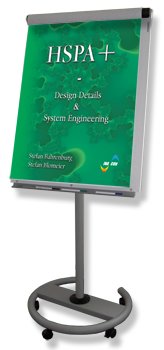 HSPA+ Design Details & System Engineering
HSPA+ Design Details & System Engineering
[2-day course, Euro 2,350.- (net) per participant]
 Training Course Description
Training Course Description

- This course offers not only a detailed explanation of all vital Rel. 7 UTRA-features but also a condensed overview which makes this course a must for everybody who needs to setup, engineer, upgrade or operate HSPA+ equipment.
- In the beginning of the course we review HSDPA and HSUPA in order to lay the foundation of HSPA+ understanding. Then we soon introduce HSPA+ and its new optional features for both UE and UTRAN. We explain what optional features are behind CPC and Enhanced FACH.
- The following part reviews important HSDPA changes made in release 6 and in a bit more depth HSUPA. Note that these sections are not intending to replace detailed HSPA trainings in INACON’s programs.
- Special focus is laid on the areas where HSPA+ improves existing HSPA networks, e.g. in terms of peak subscriber throughput, air-interface efficiency and UTRA-capacity as well latency reduction for RRC and user data transfer.
- The course continues with the elaboration of implementation of important key technologies like MIMO, higher order modulation schemes (4-PAM, 16-QAM, and 64-QAM), HS-SCCH-less operation, Enhanced FACH and Continuous Packet Connectivity (CPC).
- After this technology foundation the L1 signaling aspects are intensively covered followed by MAC and RRC HSPA+ specifics.
- In the next part we have a look into release 8 HSPA+ and work on features like 64-QAM together with MIMO and downlink interference cancellation in UE.
- The final chapter is dedicated to selected important scenarios of HSPA+ operation such as PDP context establishment, serving cell change, and the data flow
Some of your questions that will be answered
- How HSDPA has been enhanced in release 6 with F-DPCH and Pre- as well Postamble sending?
- What are the key principles of Scheduling and throughput generation in HSUPA, e.g. scaling of transport block with a certain power offset granted by NodeB?
- What are the differences in-between HSPA and HSPA+ in terms of peak data rates, efficiency and capacity?
- What is MIMO and what makes it that important for tomorrow’s mobile radio standards?
- How MIMO is introduced in HSPA+ and what needs to be changed in terms of signaling and protocols?
- How MIMO competes with downlink Dual Cell HSDPA (dual carrier HSDPA)?
- What individual features hide behind the term Continuous Packet Connectivity and what needs to be done in order to efficiently implement them in HSPA+?
- How does the new generation of Layer 1 signaling look like in HSPA+ making use of HS-SCCH, e.g. how can uplink DTX and/or downlink DRX be switched on/off by NodeB?
- How do MAC and RRC protocols change for HSPA+ and in particular with the Enhanced FACH feature set? The so called eFACH enables higher throughput rates and reduced latency when FACH and PCH are replaced by HS-DSCH in CELL_FACH and XXX_PCH states!
- When and how MIMO can be combined with 64-QAM?
- How can downlink interference cancellation be implemented in the UE?
- How HSPA+ might evolve further beyond release 8?
- Will important scenarios like PDP context activation and serving cell change de different in HSPA+?
- How DL and UL data is transferred to and from TCP/IP services?
 Who should attend this class?
Who should attend this class?
- The course is mainly targeted at UE vendor, infrastructure vendor and network operator development/testing/operating staff who need to upgrade today’s HSPA equipment/networks to HSPA+.
 Pre-Requisites
Pre-Requisites
- Participants should be already familiar with UMTS and HSPA. This should stem from previous exposure to design, troubleshooting or operations jobs in UMTS/HSPA telecommunication networks.
- HSPA+ deals to a great extend with amendments of HSPA Layer 1 but also enhances quite a bit RRC due to HS-DSCH reception in CELL_FACH and XXX_PCH so a fair knowledge of UMTS Protocol Stack architecture is advantageous.
 Training Course Target
Training Course Target
- The course enables the students to to test, to plan, and to operate HSPA+ in their specific environment, in their specific networks.
- The student will be able to judge the various implementation variants of HSPA+ and to decide on a preferred implementation and deployment of HSPA+.
 Training Course Duration
Training Course Duration
- 2 days
v3.500
ℹ️ Try out the updated search below!
Search:
More Info:
Detailed ToC of this training course
Schedule of this training course
Extract of this training course
Buy this book
Buy this book as eBook
INACON eBooks
Please have a look at our full offer

